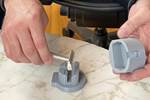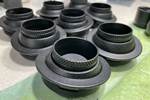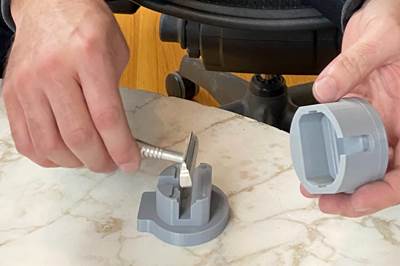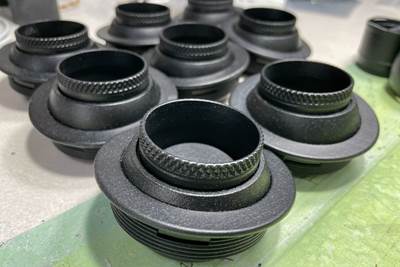Additive manufacturing (AM) supports conventional manufacturing processes like injection molding by providing a bridge to that higher volume production. AM enables manufacturers to get to a better design, and quickly get the product into the hands of customers, while conventional manufacturing is getting ramped up. By spanning the distance between the prototype and full-scale manufacturing, 3D printing can provide significant value even if some other process later takes over.
But there are scenarios where that hand-off doesn’t happen, where additive can and should win all the production work. They include:
- Parts with geometric complexity. In cases where 3D printing can deliver complex internal features like cooling channels, or combine multiple parts into one, moving to a more conventional process is likely to make manufacturing more complicated. A part like the GE Aviation fuel nozzle which consolidates 20 parts is better suited to 3D printing than an arduous manufacturing process including assembly of smaller components. AM also wins where it can introduce new functionality that would not be possible otherwise, such as 3D printed foams with varying stiffness and flexibility.
- Personalization and customization. In instances where products must be made to fit the anatomy or the tastes of individual consumers, 3D printing can deliver unique components on an accelerated timeline compared to conventional processes. AM’s lack of reliance on tooling means that there is no financial reason for every product to be identical, and the process can accommodate unique prints.
- Scenarios where conventional equipment investment would be a barrier to entry. An injection mold costing upwards of $10,000 may be out of reach for many inventors (not to mention the cost of designing and running the tool), but the same sum would buy at least a couple of desktop 3D printers. It may be far more economical to go into plastic part production with 3D printing if the volumes needed are expected to stay within a manageable range.
- Niche products that don’t demand ultra-high volumes. Similar to the above, some products will never reach a stage where demand dictates a higher-volume process. Accessories like phone cases or brackets for household electronics might become outdated, while other items might only appeal to a niche market. In these cases, AM can support on-demand production to limit inventory and match what the market can support.
- Local manufacturing. Supply chain vulnerabilities make production without tooling via 3D printing an attractive option. Rather than produce large quantities in one centralized facility, it might make sense to distribute 3D printing of smaller quantities among different facilities. Dividing production would allow manufacturers to stretch volumes down to what 3D printing capacity can handle and what is needed in that location.
I discussed these five scenarios in greater detail (with examples) with Pete Zelinski on AM Radio, our podcast about 3D printing and additive manufacturing. Listen to the relevant part of the conversation embedded below, or find AM Radio wherever you get podcasts.
Related Content
VulcanForms Is Forging a New Model for Large-Scale Production (and It's More Than 3D Printing)
The MIT spinout leverages proprietary high-power laser powder bed fusion alongside machining in the context of digitized, cost-effective and “maniacally focused” production.
Read MoreWith Electrochemical Additive Manufacturing (ECAM), Cooling Technology Is Advancing by Degrees
San Diego-based Fabric8Labs is applying electroplating chemistries and DLP-style machines to 3D print cold plates for the semiconductor industry in pure copper. These complex geometries combined with the rise of liquid cooling systems promise significant improvements for thermal management.
Read More3D Printed Titanium Replaces Aluminum for Unmanned Aircraft Wing Splice: The Cool Parts Show #72
Rapid Plasma Deposition produces the near-net-shape preform for a newly designed wing splice for remotely piloted aircraft from General Atomics. The Cool Parts Show visits Norsk Titanium, where this part is made.
Read MoreWhy AM Leads to Internal Production for Collins Aerospace (Includes Video)
A new Charlotte-area center will provide additive manufacturing expertise and production capacity for Collins business units based across the country, allowing the company to guard proprietary design and process details that are often part of AM.
Read MoreRead Next
Why Inventors and Additive Manufacturing Go Together: AM Radio #13
The ease of beginning to produce at small scales using 3D printing opens the way to a new class of manufacturer: the inventor making their own product.
Read MoreFinding the Serial Production Wins for Polymer Additive Manufacturing
Aerosport Additive is aiming to grow its serial production work by seeking out the niches where AM materials, costs and capabilities align — challenging the notion that “production” of plastic parts always means molding.
Read MoreCrushable Lattices: The Lightweight Structures That Will Protect an Interplanetary Payload
NASA uses laser powder bed fusion plus chemical etching to create the lattice forms engineered to keep Mars rocks safe during a crash landing on Earth.
Read More

.jpg;width=70;height=70;mode=crop)
















